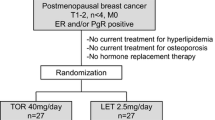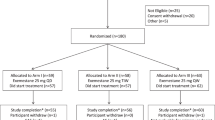Summary
Introduction. Long-term endocrine therapy for breast cancer may have clinical implications as drugs that potentially alter the lipid profile may increase the risk of developing cardiovascular disease. In this study, a companion sub-protocol to the TEAM (Tamoxifen and Exemestane Adjuvant Multicenter) International trial, we compared the effect of the steroidal aromatase inactivator exemestane on the lipid profile of postmenopausal women with early breast cancer in the adjuvant setting to that of tamoxifen.
Patients and methods. In this open-label, randomized, parallel group study, 176 postmenopausal patients with estrogen and/or progesterone receptor positive early breast cancer were randomized to either adjuvant exemestane (25 mg/day; n = 90) or tamoxifen (20 mg/day; n = 86). Assessments of total cholesterol, high-density lipoprotein (HDL), low-density lipoprotein (LDL) and serum triglycerides (TRG) were performed at baseline and every 3 months for the first 12 months.
Results. Serum triglyceride levels were consistently increased above baseline throughout the study in the tamoxifen arm, while there was a trend towards reduction in the exemestane arm. There was also an overall trend for tamoxifen to decrease the levels of LDL throughout the study period. Exemestane did not demonstrate any other significant change in HDL levels; however, there was a consistent trend for a reduction in total cholesterol in both treatment arms. The atherogenic risk determined by the TC:HDL ratio remained stable in both arms throughout the treatment period.
Conclusions. Exemestane appears to have a neutral effect on total cholesterol and HDL levels. Unlike tamoxifen’s positive effect on LDL levels, exemestane does not significantly alter LDL levels. Tamoxifen on the other hand increases triglyceride levels, while exemestane results in a beneficial reduction in TRG levels. These data offer additional information with regard to the safety and tolerability of exemestane in postmenopausal breast cancer patients and support further investigation of its potential usefulness in the adjuvant setting.
Similar content being viewed by others
References
W Yeu RJ Santen (1996) ArticleTitleAromatase inhibitors: rationale for use following antiestrogen therapy Semin Oncol 23 IssueIDSuppl 9 21–27
RW Bruggemeier (2002) ArticleTitleOverview of the pharmacology of the aromatase inactivator exemestane Breast Cancer Res Treat 74 177–185 Occurrence Handle10.1023/A:1016121822916 Occurrence Handle12186378
A Jemal A Thomas T Murray et al. (2002) ArticleTitleCancer Statistics, 2002 CA Cancer J Clin 52 23–47 Occurrence Handle11814064
HL Howe PA Wingo MJ Thun et al. (2001) ArticleTitleAnnual report to the nation on the status of cancer (1973 through 1988), featuring cancers with recent increasing trends J Natl Cancer Inst 93 824–842 Occurrence Handle10.1093/jnci/93.11.824 Occurrence Handle11390532
J Cuzick T Powles U Veronesi et al. (2003) ArticleTitleOverview of the main outcomes in breast-cancer prevention trials Lancet 361 296–300 Occurrence Handle10.1016/S0140-6736(03)12342-2 Occurrence Handle12559863
MH Gail JP Costantino J Bryant et al. (1999) ArticleTitleWeighing the risks and benefits of tamoxifen treatment for preventing breast cancer J␣Natl Cancer Inst 91 1829–1846 Occurrence Handle10.1093/jnci/91.21.1829 Occurrence Handle10547390
InstitutionalAuthorNameThe ATAC Trialists´ Group (2002) ArticleTitleAnastrozole alone or in combination with tamoxifen versus tamoxifen alone for adjuvant treatment of postmenopausal women with early breast cancer: first results of the ATAC randomized trial Lancet 359 2131–2139
PE Goss JN Ingle S Martino et al. (2003) ArticleTitleA randomized trial of letrozole in postmenopausal women after five years of tamoxifen therapy for early-stage breast cancer N Engl J Med 349 1793–1802 Occurrence Handle10.1056/NEJMoa032312 Occurrence Handle14551341
RC Coombes E Hall LJ Gibson et al. (2004) ArticleTitleA randomized trial of exemestane after two to three years of tamoxifen therapy in postmenopausal women with primary breast cancer N Engl J Med 350 1081–1092 Occurrence Handle10.1056/NEJMoa040331 Occurrence Handle15014181
Winer EP, Hudis C, Burstein HJ, et al.: American society of clinical oncology technology assessment on the use of aromatase inhibitors as adjuvant therapy for postmenopausal women with hormone receptor-positive breast cancer: Status report 2004. J Clin Oncol 23: 2005
PE Goss (1999) ArticleTitleRisks versus benefits in the clinical application of aromatase inhibitors Endocrinol Relat Cancer 6 325–332 Occurrence Handle10.1677/erc.0.0060325
D Grady SM Rubin DB Petitti et al. (1992) ArticleTitleHormone therapy to prevent disease and prolong life in postmenopausal women Ann Intern Med 117 1016–1037 Occurrence Handle1443971
E Daly M Roche D Barlow et al. (1992) ArticleTitleHRT: an analysis of benefits, risks, and costs Br Med Bull 48 368–400 Occurrence Handle1450876
RR Love DA Wiebe JM Feyzi et al. (1994) ArticleTitleEffects of tamoxifen on cardiovascular risk factors in postmenopausal women after 5 years of treatment J Natl Cancer Inst 86 1534–1539 Occurrence Handle7932809
M Elisaf E Bairaktari C Nicolaides et al. (1996) ArticleTitleThe beneficial effect of tamoxifen on serum lipoprotein-A levels: an additional anti-atherogenic property Anticancer Res 16 2725–2728 Occurrence Handle8917378
BW Brown C Brauner MC Minotte (1993) ArticleTitleNon-cancer deaths in white adult cancer patients J Natl Cancer Inst 85 979–987 Occurrence Handle8496983
TR Evans E Di Salle G Ornati et al. (1992) ArticleTitlePhase I and endocrine study of exemestane (FCE24304), a new aromatase inhibitor, in postmenopausal women Cancer Res 52 5933–5939 Occurrence Handle1394219
D Giudici G Ornati G Briatico et al. (1988) ArticleTitle6-Methylenandrosta-1,4-diene-3,17-dione (FCE24304): a new irreversible aromatase inhibitor J Steroid Biochem 30 391–394 Occurrence Handle10.1016/0022-4731(88)90129-X Occurrence Handle3386266
J Geisler N King G Anker et al. (1998) ArticleTitleIn vivo inhibition of aromatization by exemestane, a novel irreversible aromatase inhibitor, in postmenopausal breast cancer patients Clin Cancer Res 4 2089–2093 Occurrence Handle9748124
G Atalay L Dirix L Biganzoli et al. (2004) ArticleTitleThe effect of exemestane on serum lipid profile in postmenopausal women with metastatic breast cancer: a companion study to EORTC Trial 10951, “Randomized phase II study in first line hormonal treatment for metastatic breast cancer with exemestane or tamoxifen in postmenopausal patients” Ann Oncol 15 211–217 Occurrence Handle10.1093/annonc/mdh064 Occurrence Handle14760111
JC LaRosa (1997) ArticleTitleTriglycerides and coronary risk in women and the elderly Arch Intern Med 157 961–968 Occurrence Handle10.1001/archinte.157.9.961 Occurrence Handle9140266
P Cullen (2000) ArticleTitleEvidence that triglycerides are an independent coronary heart disease risk factor Am J Cardiol 86 943–949 Occurrence Handle10.1016/S0002-9149(00)01127-9 Occurrence Handle11053704
T Engan J Krane DG Johannessen et al. (1995) ArticleTitlePlasma changes in breast cancer patients during endocrine therapy – lipid measurements and nuclear magnetic imaging (NMR) spectroscopy Breast Cancer Res Treat 36 287–297 Occurrence Handle10.1007/BF00713400 Occurrence Handle8573711
M Gershanovich HA Chaudri D Campos et al. (1998) ArticleTitleLetrozole, a new oral aromatase inhibitor: randomized trial comparing 2.5 mg daily, 0.5 mg daily and aminoglutethimide in postmenopausal women with advanced breast cancer. Letrozole International Trial Group (AR/BC3) Ann Oncol 9 639–645 Occurrence Handle10.1023/A:1008226721932 Occurrence Handle9681078
C Nicolaides M Elisaf E Bairaktari et al. (2001) ArticleTitleEffect of letrozole on the lipid profile in postmenopausal women with breast cancer Eur J Cancer 37 1510–1513 Occurrence Handle10.1016/S0959-8049(01)80834-0 Occurrence Handle11506958
CL Harper-Wynne NPM Sacks K Shenton et al. (2002) ArticleTitleComparison of the systemic and intratumoral effects of tamoxifen and the aromatase inhibitor vorozole in postmenopausal patients with primary breast cancer J Clin Oncol 20 1026–1035 Occurrence Handle10.1200/JCO.20.4.1026 Occurrence Handle11844826
HM Hesmati S Khosla SP Robins et al. (2002) ArticleTitleRole of low levels of endogenous estrogen in regulation of bone resumption in late postmenopausal women J Bone Miner Res 17 172–178 Occurrence Handle11771665
J Wojtacki W Kruszewski M Sliwinska et al. (2000) ArticleTitleEffect of non steroidal aromatase inhibitors (AI) on serum lipid profile in patients with breast cancer. Preliminary report Eur J Cancer 36 S5–(Abstr 146)
J Bonneterre A Budzar JM Nabholtz et al. (2001) ArticleTitleAnastrozole is superior to tamoxifen as first-line therapy in hormone receptor positive advanced breast carcinoma Cancer 92 2247–2258 Occurrence Handle10.1002/1097-0142(20011101)92:9<2247::AID-CNCR1570>3.0.CO;2-Y Occurrence Handle11745278
JM Nabholtz AU Budzar M Pollak et al. (2000) ArticleTitleAnastrozole is superior to tamoxifen as first line treatment for advanced breast cancer in postmenopausal women: results of North American Multicenter Randomized Trial J Clin Oncol 18 3758–3767 Occurrence Handle11078488
J Bonneterre B Thurliman JFR Robertson et al. (2000) ArticleTitleAnastrozole versus tamoxifen as first line treatment for advanced breast cancer in 668 postmenopausal women: results of the tamoxifen or Arimidex randomized Group Efficacy and Tolerability Study J␣Clin Oncol 18 3748–3757 Occurrence Handle11078487
LAM Costa MS Kopreski LM Demers et al. (1999) ArticleTitleEffect of the potently aromatase inhibitor fadrozole hydrochloride (CGS 16949A) in postmenopausal women with breast carcinoma Cancer 85 100–103 Occurrence Handle10.1002/(SICI)1097-0142(19990101)85:1<100::AID-CNCR14>3.0.CO;2-5 Occurrence Handle9921980
N Zilembo C Noberasco E Bajetta et al. (1995) ArticleTitleEndocrinological and clinical evaluation of exemestane, a new steroidal aromatase inhibitor Br J Cancer 72 1007–1012 Occurrence Handle7547212
E Di Salle G Ornati D Giudici et al. (1992) ArticleTitleExemestane (FCE24304), a new steroidal aromatase inhibitor J Steroid Biochem Mol Biol 43 137–143 Occurrence Handle10.1016/0960-0760(92)90198-R Occurrence Handle1525055
Center for Drug Evaluation and Research Application Number NDA 20753 (Exemestane) Medical Review. U.S. Food and Drug Administration, Rockville, MD, 1999
C Packard M Caslake J Shepherd (2000) ArticleTitleThe role of small, dense low density lipoprotein (LDL): a new look Intern J Cardiol 74 IssueIDS 17–22 Occurrence Handle10.1016/S0167-5273(99)00107-2
J Dewar J-MA Nabholtz J Bonneterre (2000) ArticleTitleThe affect of anastrozole (Arimidex) on serum lipids-data from a randomized comparison of anastrozole (AN) vs tamoxifen (TAM) in postmenopausal (PM) women with advanced breast cancer (ABC) Breast Cancer Res Treat 64 51–(Abstr 164)
Author information
Authors and Affiliations
Corresponding author
Rights and permissions
About this article
Cite this article
Markopoulos, C., Polychronis, A., Zobolas, V. et al. The Effect of Exemestane on the Lipidemic Profile of Postmenopausal Early Breast Cancer Patients: Preliminary Results of the TEAM Greek Sub-study. Breast Cancer Res Treat 93, 61–66 (2005). https://doi.org/10.1007/s10549-005-3783-0
Issue Date:
DOI: https://doi.org/10.1007/s10549-005-3783-0




